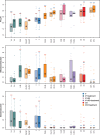Infant gut microbiota restoration: state of the art
- PMID: 36093611
- PMCID: PMC9467569
- DOI: 10.1080/19490976.2022.2118811
Infant gut microbiota restoration: state of the art
Abstract
The gut microbiota has a central role in the programming of the host's metabolism and immune function, with both immediate and long-term health consequences. Recent years have witnessed an accumulation of understanding of the process of the colonization and development of the gut microbiota in infants. The natural gut microbiota colonization during birth is frequently disrupted due to C-section birth or intrapartum or postpartum antibiotic exposure, and consequently aberrant gut microbiota development is common. On a positive note, research has shown that restoration of normal gut microbiota development is feasible. We discuss here the current understanding of the infant microbiota, provide an overview of the sources of disturbances, and critically evaluate the evidence on early life gut microbiota restoration for improved health outcomes by analyzing published data from infant gut microbiota restoration studies.
Keywords: Intrapartum antibiotics; birth mode; breastfeeding; cesarean section; fecal microbiota transplant; lactic acid bacteria and bifidobacteria; vaginal seeding.
Conflict of interest statement
No potential conflict of interest were disclosed.
Figures



References
-
- Korpela K, Helve O, Kolho K, Saisto T, Skogberg K, Dikareva E, Stefanovic V, Salonen A, Andersson S, de Vos WM. Maternal fecal microbiota transplantation in cesarean-born infants rapidly restores normal gut microbial development: a proof-of-concept study. Cell. 2020;183(2):324–334. doi:10.1016/j.cell.2020.08.047. - DOI - PubMed
Publication types
MeSH terms
Substances
LinkOut - more resources
Full Text Sources
Medical
